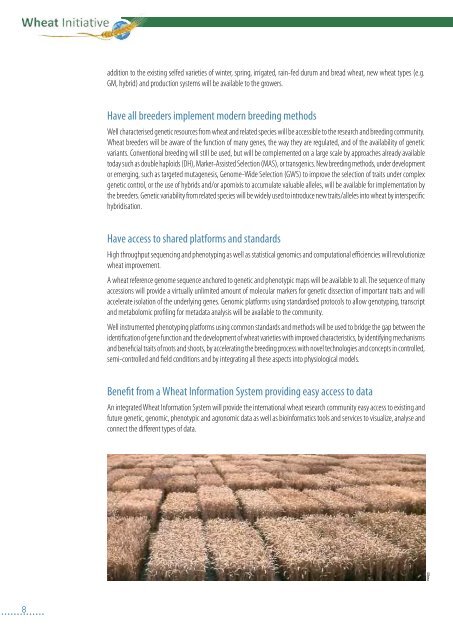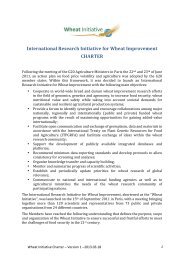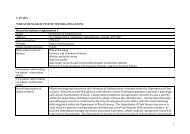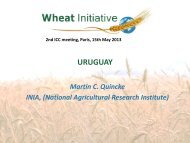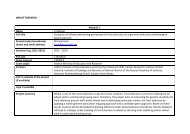An international vision for wheat improvement - Wheat Initiative
An international vision for wheat improvement - Wheat Initiative
An international vision for wheat improvement - Wheat Initiative
You also want an ePaper? Increase the reach of your titles
YUMPU automatically turns print PDFs into web optimized ePapers that Google loves.
addition to the existing selfed varieties of winter, spring, irrigated, rain-fed durum and bread <strong>wheat</strong>, new <strong>wheat</strong> types (e.g.<br />
GM, hybrid) and production systems will be available to the growers.<br />
Have all breeders implement modern breeding methods<br />
Well characterised genetic resources from <strong>wheat</strong> and related species will be accessible to the research and breeding community.<br />
<strong>Wheat</strong> breeders will be aware of the function of many genes, the way they are regulated, and of the availability of genetic<br />
variants. Conventional breeding will still be used, but will be complemented on a large scale by approaches already available<br />
today such as double haploids (DH), Marker-Assisted Selection (MAS), or transgenics. New breeding methods, under development<br />
or emerging, such as targeted mutagenesis, Genome-Wide Selection (GWS) to improve the selection of traits under complex<br />
genetic control, or the use of hybrids and/or apomixis to accumulate valuable alleles, will be available <strong>for</strong> implementation by<br />
the breeders. Genetic variability from related species will be widely used to introduce new traits/alleles into <strong>wheat</strong> by interspecific<br />
hybridisation.<br />
Have access to shared plat<strong>for</strong>ms and standards<br />
High throughput sequencing and phenotyping as well as statistical genomics and computational efficiencies will revolutionize<br />
<strong>wheat</strong> <strong>improvement</strong>.<br />
A <strong>wheat</strong> reference genome sequence anchored to genetic and phenotypic maps will be available to all. The sequence of many<br />
accessions will provide a virtually unlimited amount of molecular markers <strong>for</strong> genetic dissection of important traits and will<br />
accelerate isolation of the underlying genes. Genomic plat<strong>for</strong>ms using standardised protocols to allow genotyping, transcript<br />
and metabolomic profiling <strong>for</strong> metadata analysis will be available to the community.<br />
Well instrumented phenotyping plat<strong>for</strong>ms using common standards and methods will be used to bridge the gap between the<br />
identification of gene function and the development of <strong>wheat</strong> varieties with improved characteristics, by identifying mechanisms<br />
and beneficial traits of roots and shoots, by accelerating the breeding process with novel technologies and concepts in controlled,<br />
semi-controlled and field conditions and by integrating all these aspects into physiological models.<br />
Benefit from a <strong>Wheat</strong> In<strong>for</strong>mation System providing easy access to data<br />
<strong>An</strong> integrated <strong>Wheat</strong> In<strong>for</strong>mation System will provide the <strong>international</strong> <strong>wheat</strong> research community easy access to existing and<br />
future genetic, genomic, phenotypic and agronomic data as well as bioin<strong>for</strong>matics tools and services to visualize, analyse and<br />
connect the different types of data.<br />
©Inra<br />
8


